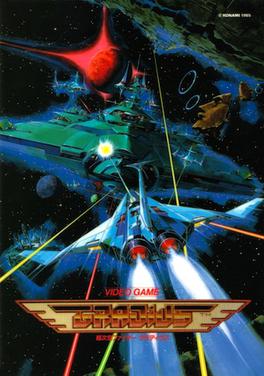
Gradius is a side-scrolling shooter video game developed and published by Konami. The first game in the Gradius series, it was originally released as a coin-operated arcade game in 1985. The player maneuvers a spacecraft known as the Vic Viper that must defend itself from the various alien enemies. The game uses a power-up system called the "power meter", based upon collecting capsules to purchase additional weapons.

Contra is a run and gun video game developed and published by Konami, originally developed as a coin-operated arcade video game in 1986 and released on February 20, 1987. A home version was released for the Nintendo Entertainment System in 1988, along with ports for various home computer formats, including the MSX2. The arcade and computer versions were localized as Gryzor in Europe, and the NES version as Probotector in PAL regions and France.

Salamander, retitled Life Force in North America and in the Japanese arcade re-release, is a scrolling shooter arcade video game developed and published by Konami. Released in 1986 as a spin-off of Gradius, Salamander introduced a simplified power-up system, two-player cooperative gameplay and both horizontally and vertically scrolling stages. Some of these later became normal for future Gradius games. In Japanese, the title is written using ateji, which are kanji used for spelling foreign words that has been supplanted in everyday use by katakana. Contra, another game by Konami was also given this treatment, with its title written in Japanese as 魂斗羅.

Gunstar Heroes is a run and gun video game developed by Treasure and published by Sega. It was Treasure's debut game, originally released for the Sega Genesis in 1993. The game's premise is centered around a pair of characters, the Gunstars, in their efforts to stop an evil empire from recovering four powerful gems. The characters can fire guns and perform a series of acrobatic maneuvers to fight enemies across each stage. There are four weapons in the game which can be combined with one another to create different shot types.

Castlevania III: Dracula's Curse is a 1989 platform game developed and published by Konami for the Nintendo Entertainment System. It was released in Japan in 1989, and in North America in 1990, and in Europe by Palcom in 1992. It was later released on the Virtual Console for the Wii, Nintendo 3DS, and Wii U.

Contra Force is an run and gun game released by Konami for the Nintendo Entertainment System in 1992 in North America. It is a spinoff of the Contra series, being the third game in the series released for the NES following the original Contra and Super Contra. However, the game's plot and setting are unrelated to both previous and succeeding entries, as the villains in the game are human terrorists instead of an alien menace. The game was scheduled to be released in Japan under the title of Arc Hound, with no ties to the Contra series, but was cancelled.

Teenage Mutant Ninja Turtles III: The Manhattan Project is a side-scrolling beat-'em-up released by Konami for the Family Computer (Famicom) in Japan in 1991 and for the Nintendo Entertainment System in North America in 1992. It is the third video game iteration of the Teenage Mutant Ninja Turtles for the NES. The game features play mechanics similar to the previous game, Teenage Mutant Ninja Turtles II: The Arcade Game, but it is an original title for the NES without any preceding arcade version. It is based on the 1987 Teenage Mutant Ninja Turtles animated series, being released after the show's 5th season. The game was re-released as part of Teenage Mutant Ninja Turtles: The Cowabunga Collection in 2022.
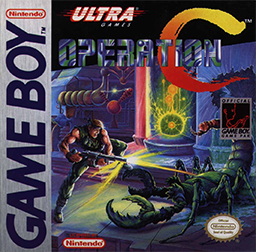
Operation C is a 1991 run and gun video game by Konami released for the Game Boy. It is a sequel to Super Contra, and the first portable installment in the Contra series. Operation C features gameplay and graphics similar to the Nintendo Entertainment System versions of Contra and Super Contra.

Contra: Hard Corps, released as Contra: The Hard Corps in Japan and Probotector in Europe and Australia, is a run and gun video game released by Konami for the Sega Genesis in 1994, making it the first game in the Contra series released for a Sega platform.
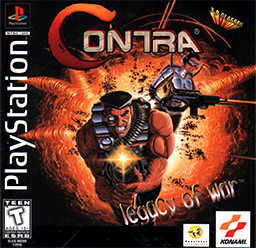
Contra: Legacy of War is a 3D action game produced by Konami and developed by Appaloosa Interactive that was originally released in 1996 for the PlayStation and Sega Saturn. It is a follow-up to Contra: Hard Corps, and was the first of two games in the Contra series that were externally developed by Appaloosa; the second game, C: The Contra Adventure, was released in 1998. Legacy of War marks the series' shift to three-dimensional graphics and gameplay, the game was released packaged with a pair of 3D anaglyph glasses, which enables the player to view the 3D effects incorporated into the game's graphics. Legacy of War bears the distinction for being the first console game in the series to retain both the Contra title and human characters during its release in Europe and Australia. The game was scheduled to be released in Japan as well, but was cancelled.
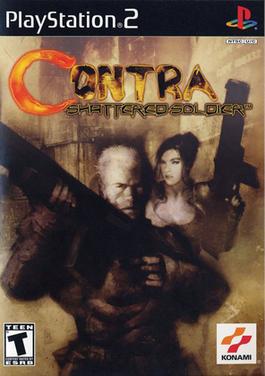
Contra: Shattered Soldier, originally released in Japan as Shin Contra, is a video game that is part of the Contra series by Konami. It was developed by Team Kijirushi, a group of staff members within Konami Computer Entertainment Tokyo. The game marks a return to the two-dimensional gameplay style employed by the series prior to Contra: Legacy of War. A sequel to Contra: Hard Corps, the game was released for the PlayStation 2 in 2002 and for the PlayStation Network in both 2012 for Japan and 2013 for North America.

Neo Contra is the tenth video game in the Contra series published by Konami. It was developed by Team Neo Kijirushi, a group of staff members within Konami Computer Entertainment Tokyo, and released for the PlayStation 2 in 2004. The game is a direct follow-up to Contra: Shattered Soldier, but returns to the multidirectional shooting format and departs from the traditional scrolling shooter formula used in previous games. It was the first game in the series to receive an M (Mature) rating from the ESRB and was the only installment to receive this rating until the release of Rogue Corps in 2019.
Gradius is a series of shooter video games, introduced in 1985, developed and published by Konami for a variety of portable, console and arcade platforms. In many games in the series, the player controls a ship known as the Vic Viper.

Contra 4 is a 2D action game published by Konami Digital Entertainment in the United States and developed by WayForward Technologies. It is the eleventh overall installment of the Contra series, and was released in North America on November 13, 2007 for Nintendo DS. A mobile port was released six days later on November 19, 2007. A rerelease, called Contra 4: Redux, was released for Android in 2011.

Contra ReBirth is a 2D run and gun video game developed by M2 and published by Konami for WiiWare. It is the twelfth original installment in the Contra series. It was released in Japan on May 12, 2009, the PAL region on September 4, 2009, and North America on September 7, 2009.

Hard Corps: Uprising is a run and gun video game developed by Arc System Works and published by Konami for the Xbox 360 and the PlayStation 3. The game was released digitally on Xbox Live Arcade on February 16, 2011 and on the PlayStation Network in March 2011. In Hard Corps: Uprising, the player assumes the role of an elite soldier simply called Bahamut, along with other main characters. Konami has added three additional player characters via downloadable content.

Super Contra, known as Super Contra: The Alien Strikes Back in Japan, is a run and gun video game by Konami, originally released as a coin-operated arcade video game in January 1988. It is the sequel to the original Contra and part of the Contra series. The game stars Bill Rizer and Lance Bean as they are sent to thwart another alien invasion from the vicious Red Falcon.

Contra III: The Alien Wars is a 1992 run and gun video game developed and published by Konami for the Super Nintendo Entertainment System (SNES). It is the third home console entry in the Contra series after Contra (1988) and Super C (1990) for the Nintendo Entertainment System (NES). In PAL regions, it was retitled Super Probotector: Alien Rebels and the player characters were replaced with robots. The player is tasked with fighting off an alien invasion of Earth across six stages. Four stages feature side-scrolling action traditional to the series while two are presented from an overhead perspective. It is the first Contra title to have been directed by Nobuya Nakazato who later directed other games in the series. He designed Contra III to feature more comical elements, a more cinematic soundtrack, and tighter stage design than its predecessors.

Gradius III is a 1989 scrolling shooter video game developed and published by Konami, originally released for the arcades in Japan and other parts of Asia on December 11, 1989. It is the third game in the Gradius series. The game was ported to the Super Nintendo Entertainment System in Japan in 1990 and North America in 1991, and served as a launch title for the system in North America. The arcade version would never see the light of day in the West until it was included alongside Gradius IV in a two-in-one compilation for the PlayStation 2 and in the Gradius Collection for the PlayStation Portable.
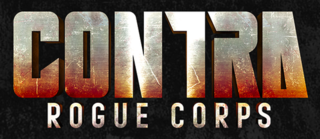
Contra: Rogue Corps is a run and gun twin-stick shooter in the Contra series developed by Toylogic and published by Konami. It was released on September 24, 2019 for the Nintendo Switch, PlayStation 4, Windows, and Xbox One.



















